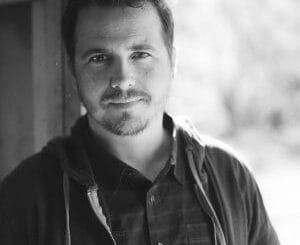Gerard Lough
He is the man behind The Boogeyman Dollar Baby Film.
SKSM: Could you start with telling me a bit about yourself? Who are you and what do you do?
Gerard Lough: I am a 32 year old film-maker from Ireland with nine music videos and six short films under my belt. I am also a writer and The Boogeyman is my first adaptation of someone else’s work.
SKSM: When did you make The Boogeyman? Can you tell me a little about the production? How much did it cost? How long did it take to film it?
Gerard Lough: The Boogeyman had its first screening in August at a film festival in Dublin. From when we had a finished script till its premiere, that period took seven months. The film was made on a budget of two thousand euros. The reasons why the film looks much more expensive are because nobody took a fee, I had my own equipment, the editing suite was set up at my home and crew members took on multiple roles. For example the producer, Martin Neely, also built a camera dolly (so we could do slick looking tracking shots) as well as moonlighting as a stills photographer. The visual effects supervisor, Emmet Griffin, also designed the posters and titles for the trailer.
The film was made on resources that were limited and there never seemed to be enough time when we were shooting. Because of the Dollar Baby rule that the finished film cannot be commercially exploited, it rules out financial investment from any other party as it would be an investment they could never hope to see a return on. This meant that the film was made independently. The plus side of this situation is that there was never any outside interference; it could never be a case of “too many cooks spoil the broth”. A greatly enhanced budget would have made for a slicker looking film but the down side might have been a pressure to tone down the unlikable aspects of Billing’s character or opt for a happy ending.
SKSM: How come you picked The Boogeyman to develop into a movie? What is it in the story that you like so much?
Gerard Lough: I have always been interested in psychology and how professionals in that field can examine a person’s past in order to find the key to an obsession or dysfunctional personality trait. The Boogeyman deals with this subject as well as themes such as how we can remember a version of the past that is more convenient than accurate. The story worked on two levels for me. It was a well told scary yarn as well as being a sophisticated critique of male immaturity and parental neglect. Billings can conjure up a different version of events and convince himself of their veracity but he can’t escape the guilt that stalks him just as relentlessly as the Boogeyman. It’s these dark and complex themes that attracted me to the story.
SKSM: Now that your film is finished, don’t you think… I would be doing this different?
Gerard Lough: The only difference I would make If I were to remake the film are technical things such as shooting the film on a RED camera in 2:35:1 aspect ratio and do the post production on Avid Software. However the key thing was not a question of format or look but whether we told the story well and treated the source material with respect, which we did. The finished film is exactly what was intended. Something that not all directors can say when they look back on a film.
SKSM: What kind of problems did you run into while filming?
Gerard Lough: A harsh lesson for all young film makers is that you can’t plan for everything. For example the shooting schedule was carefully organized but had to be dramatically changed at the last minute when a key member of our team had to leave early to have a quadruple heart by-pass. As James Cameron once said “man proposes and god disposes” and it’s these curve balls that every director must prepare for.
A problem we did see coming was the great difficulty in finding parents who would allow us to let there children appear in a movie about a creature that kills kids. It’s easy to forget how superstitious people can be and how urban myths about people who appear in scary movies and then come to a sticky end in real life are still with us. I remember these stories from school. Nonsense such as the entire cast and crew of The Exorcist dying mysteriously after the films release.
SKSM: How did you find out that King sold the movie rights to some of his stories for just $1? Was it just a wild guess or did you know it before you sent him the check?
Gerard Lough: There was an excellent documentary on the special edition dvd of The Shawshank Redemption where presenter Mark Kermode mentioned how Frank Darabont got his start by making the dollar baby of The woman In The Room.
It was also around this time that I was searching for a commercial edge for my next short film project. Some get that edge by getting a well known actor to appear, have a famous band do the music or adapt a story by a best selling author. Even for shorts it’s a competitive world out there and you need every inch you can get to stand out from the pack.
SKSM: Was there any funny or special moment when you made the movie that you would like to tell me about?
Gerard Lough: For me the most special moment was seeing the finished film on a 50ft screen in a cinema at a film festival screening. It’s at this moment that your film will look and sound it’s best and it’s very rewarding to see your dream become a reality and playing before an appreciative audience.
SKSM: How does it feel that all the King fans out there can’t see your movie? Do you think that will change in the future? Maybe an internet/dvd release would be possible?
Gerard Lough: Yes it is a little frustrating that not everyone who wants to see the film can unless it happens to be playing at a film festival in their town. I understand the legal reasons for why this is, but yes a rare exception now and again would be nice. For example a ‘best of’ DVD release would be a terrific treat for fans while also being great exposure for the film makers. Or releasing about a dozen dollar babies every year for download on I-tunes would also be a great incentive for film makers.
SKSM: Did you have any personal contact with King during the making of the movie? Has he seen it (and if so, what did he think about it)?
Gerard Lough: I have been in touch with his people but have had no direct contact with the great man himself. It’s been a typically busy and prolific year for him with his stories seeming to appear in every medium there is and it is just not possible for him to write back to everyone. But yes, I would love to know what he thought of our version of The Boogeyman. I would like to think that upon watching it he concluded that the film-makers did take the material very seriously and were faithful to it throughout.
SKSM: What did you think of the first The Boogeyman (1982) directed by Jeff Schiro?
Gerard Lough: I was aware of an older version but I elected not to look at it as I didn’t want it to influence me in any way whether consciously or unconsciously. I have had a look at it recently and I think it lacked ambition….. even for 1982. But I have noted that some fans seem to be very fond of it so it is just a question of taste I suppose.
SKSM: What is the difference between the 1982 version and your version? Beside 28 years?
Gerard Lough: The biggest difference is that our version is not confined to the therapist’s office for most of the running time, we actually show you Billings’ back story by using flashbacks with a voice over narration. I also thought it would be a real shame not to show the Boogeyman. I thought it would be exciting to have a creature designed and put on screen by using the skills of make-up artist Julie-Ann Ryan and then photograph it in interesting ways. I was influenced by Alien in this regard, which is to say we only gave glimpses of the creature and it was lit very carefully each time.
SKSM: The boogeyman looks very scary, how did that happen?
Gerard Lough: I think it’s because it’s real and it’s not a CGI creature even though that was an option discussed early on. We also never see too much of the creature which gave it a strange, dream-like quality. I always knew that I wanted the audience to consider the possibility that it isn’t real, it’s just a figment of Billings’ troubled imagination. The creature was designed by James Friel – a talented artist who had done concept art and story boards for my previous films. The designs were then brought to life by Julie-Ann Ryan – one of the best SFX make-up artists in Ireland and a former student of legendary make-up artist Dick Smith. I think the creature looks a bit like a 6ft turtle that has been in a terrible road accident! Another direction discussed at one point was a creature design inspired by the villains in The Dark Crystal.
SKSM: Do you have any plans for making more movies based on Stephen King’s stories? If you could pick – at least – one story to shoot, which one would it be and why?
Gerard Lough: I was interested in Jerusalem’s Lot at one point as I think a prequel to Salem’s Lot could be interesting but this short story was told by a collection of letters written by the main character and I think this would be a tricky technique to translate successfully into a visual medium.
SKSM: Thanks for taking the time to answer my questions. Is there anything you want to say to your fans?
Gerard Lough: I would like to thank the people at Stephen King short movies for their support and to Boogeyman fans who have seen the new version and appreciated what we have done. A few people have made a snap judgment on the film just from seeing the trailer and have reacted in a negative way to which I would say don’t judge it until you have seen the whole film. Judging a movie by a trailer is a bit like judging a book by it’s cover. For those who have seen it, the film has a page on the IMDB so you can go there and air your views, rate it out of ten, write a review, etc.
SKSM: Do you have anything you’d like to add?
Gerard Lough: I have two pieces of advice for anyone thinking of making a dollar baby.
1. Choose your story carefully, something that you can connect too on a personal level, something that you feel that you could bring something unique to if you were to adapt it for the screen.
2. Take your time adapting it into a strong screenplay. If something has to change for the story to work as a film, so be it. Although a good script won’t guarantee a good film, it will at least attract talented people and give you a shot at creating something special that you will be proud to have worked on.

















